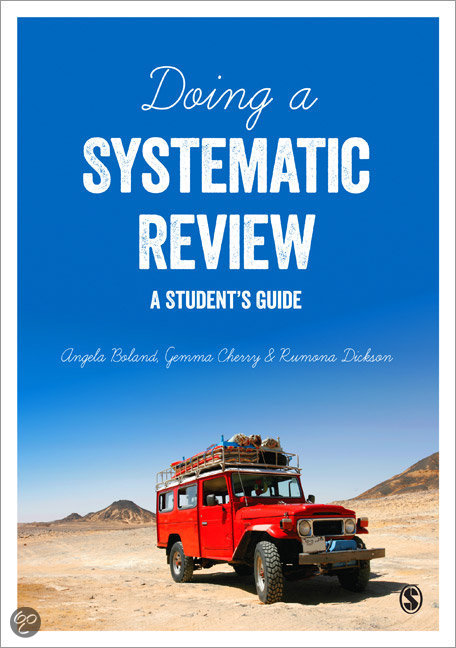Writing a systematic review is one of the most challenging aspects of the academic process. With Doing a Systematic Review: A Student’s Guide, Angela Boland, M. Gemma Cherry and Rumona Dickson aim to offer a detailed and effective guide to writing a successful systematic review. This takes the book beyond the usual “How to…” literature, and makes it a valuable resource for both students as well as more experienced researchers, writes Sophie Lecheler.
 Doing a Systematic Review: A Student’s Guide. Angela Boland, M. Gemma Cherry & Rumona Dickson (eds.). SAGE. November 2013.
Doing a Systematic Review: A Student’s Guide. Angela Boland, M. Gemma Cherry & Rumona Dickson (eds.). SAGE. November 2013.
There are many books published on the question of how to write a systematic review. So, what does this book bring to the table?
Initially, it offers the usual themes relevant for writing a review: a general introduction (Chapter one), a guide towards formulating research questions (Chapter two), finding literature (Chapter three), analysing and discussing this literature (Chapters four, five and six), coming to appropriate conclusions (Chapter seven) and how to time manage writing a systematic review (Chapter ten). It also offers some insights into the difference between reviewing qualitative and quantitative literature (Chapter eight), albeit from the perspective of a discipline that largely relies on quantitative methods (health-related research). Finally, there is a chapter on conducting a review on economic evaluations (Chapter nine), which is arguably less interesting for students in other disciplines. This is an edited book, so each chapter is written by a different team of authors – almost all of which specialise in systematic reviews and are members of the Liverpool Reviews and Implementation Group at the University of Liverpool.
Upon closer inspection, many chapters offer much more than just a general “How to…”. For instance, in Chapter three, Yenal Dundar and Nigel Fleeman provide strings of search terms (Box 3.1, p. 40), which can be used to search academic databases in order to find literature for the review. They also list a wide range of such academic databases (p. 43). Several chapters offer full text examples of well thought-out emails that can be sent to experts and academics with requests for additional information about the topic of the review. All chapters end with a summary of key points to think about when writing the review, and a box titled “what an examiner is looking for in your thesis”, which details quality criteria for each section of the systematic review. Chapters have a Frequently Asked Questions section, which have been developed from previous experiences of the authors. When considering all of these features, the book automatically becomes a valuable resource for teaching. Teachers might use any of the provided examples to clarify the different steps necessary for conducting a systematic review in class. For instance, Chapter two provides a number of “recipes” for successfully formulating research questions (e.g., Table 2.1., p. 20; Box 2.1, p. 24).
As the editors themselves note, this book is directed at students at the postgraduate level. This means that almost all chapters in the book require a certain level of knowledge regarding the empirical research process, research methods as well as data analysis. While this limits the use of this book for undergraduate teaching, it also brings two advantages: first, it enables the authors to provide in-depth and very practical knowledge on each stage of writing a systematic review; and second, it renders this book very relevant to more experienced researchers who aim to improve their grasp of how to conduct and publish a systematic review. This more in-depth approach is visible at several stages in the book: Chapter six offers a comprehensive overview of how to present numerical data from reviewed studies. However, it also provides help with deciding when to include a formal meta-analysis in the review. Additionally, several chapters offer example tables that show how to present study characteristics and review data in text. It is likely that both of these aspects are a concern of even experienced researchers when writing a systematic review.

As this book is written by researchers working the field of health-related research, students of other disciplines might have to adapt to some of the more specific guidelines and jargon in the book. For example, the book relies on many literature examples featuring quantitative human subject research (e.g., surveys, experimental designs). This could be an obstacle to students interested in other methods, such as textual analysis (e.g., with regards to quality assessment, Chapter four). Overall, however, the book is clear and will be easily readable for students from a wide variety of disciplines.
The book also offers the possibility of transferring standards of systematic reviewing used in health-related research to other literatures with similar empirical research methods. For instance, many of the quality assessment criteria named in Chapter four could provide new insights for students and researchers reviewing experimental studies in political science or mass communication research. Arguably, the focus on health-related research might prove most problematic for systematic reviews of qualitative literature. Chapter eight provides a useful introduction, which stresses the importance of reviewing qualitative studies. It also has some insights on how to write reviews that combine qualitative and quantitative data. Nevertheless, more information from elsewhere might be necessary for those interested in reviewing qualitative research.
Doing a Systematic Review is well-structured and tightly-packed with practical advice. It is a rare book which goes beyond the more general student textbooks on writing reviews. The book is particularly useful for postgraduate students for its focus on what the examiner wants, and offers a range of very practical snippets of information on the process of writing a review. It will also be a valuable resource for teachers wishing to improve their students’ writing, and for researchers who want to learn more about conducting a systematic review to a high standard.
—————————————————————–
Dr Sophie Lecheler is a Marie Curie Research Fellow at the Department of Government at the LSE and an Assistant Professor of Political Communication at the Amsterdam School of Communication Research (ASCoR) at the University of Amsterdam, The Netherlands. Her research focuses on political journalism in the EU and the effects of journalistic news on citizens’ political attitudes and behaviour. She is currently working on a project on the role of emotions in European political communication. She tweets at @Sophelpoffel. Read reviews by Sophie.








1 Comments